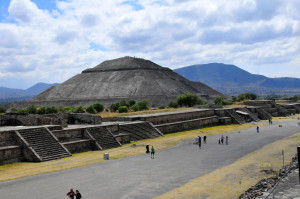For anyone with an insatiable desire to see ancient pyramids and for whom a trip to Egypt is out of the question, a trip to Mexico offers an ideal solution. Just a few miles from Mexico City are the monumental pyramids of Teotihuacan, one of the world’s most important cities during the first millennium.
Teotihuacan was founded as a religious center on a highlands plateau in about 200 B.C. Exactly who founded the city is not clear, at least in part because its inhabitants left few if any written records. What is clear is that the city grew and eventually included people from various ethnic groups.
By 600 A.D., Teotihuacan had a population of up to 200,000, making it the largest and most important city in what are now the Americas and the sixth largest city in the world, about a third the size of Constantinople. Multi-story apartment buildings accommodated the large urban population, which included skilled potters and artists whose remarkably well preserved murals are still on display.
Teotihuacan’s famous brick and stone pyramids are connected by a broad boulevard. The Pyramid of the Sun, constructed in about 100 A.D. along the boulevard, is the third largest pyramid in the world. At 733 feet per side, its square base is about the size of that of the Great Pyramid of Giza but it rises only half as high. The Pyramid of the Moon and the Pyramid of the Feathered Serpent, at opposite ends of the boulevard, are smaller but equally impressive because they, like the Pyramid of the Sun, were constructed without pack animals or the wheel.
The pyramids of Teotihuacan were apparently built as places of worship, with temples to influential gods on their flattened summits. Bodies buried in the pyramids with their hands tied have been interpreted as sacrifices to those gods, probably made at the times the temples were dedicated.
Teotihuacan collapsed in the seventh or eighth centuries, after the sacking and destruction of its major buildings. Archaeological evidence suggests an insurrection. When Aztecs later discovered the ruins, they concluded that the universe had started at Teotihuacan and gave the city its current name, which means “the birthplace of the gods.” Mistaking the pyramids for tombs, they named its boulevard the “Avenue of the Dead,” a name it retains.
Americans often assume they must cross an ocean to see the important cities of antiquity. But at about the time Rome was falling to the barbarians, Teotihuacan in nearby Mexico rivaled the great cities of the world in size and influence. A trip there provides the bonus of seeing a collection of pyramids whose only real rivals are in Egypt.
